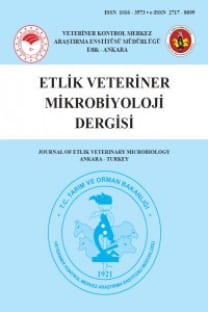Quorum Sensing
Quorum sensing, prokaryot, regülon, ökaryot, iletişim., Hakan YARDIMCI, İnci Başak KAYA, Etlik Veteriner Mikrobiyoloji Dergisi, 2014
Quorum Sensing
Communication, eukaryote, prokaryote, regulon, quorum sensing.,
___
- Ansaldi M, Marolt D, Stebe T, Mandic-Mulec I, Dubnau D, (2002). Specific activation of the Bacillus quorumsensing systems by isoprenylated pheromone variants. Mol Microbiol. 44, 1561-73.
- Dagkessamanskaia A, Moscoso M, Henard V, Guiral S, Overweg K, Reuter M, Martin B, Wells J, Claverys JP, (2004). Interconnection of competence, stress and CiaR regulons in Streptococcus pneumoniae: competence triggers stationary phase autolysis of ciaR mutant cells. Mol Microbiol. 51, 1071-86.
- Gallio M, Sturgill G, Rather P, Kylsten P, (2002). Aconserved mechanism for extracellular signaling in eukaryotes and prokaryotes. Proc Natl Acad Sci. USA 99, 12208-13.
- Gould TA, Schweizer HP, Churchill ME, (2004). Structure of the Pseudomonas aeruginosa Acyl-homoserinelactone synthase LasI. Mol Microbiol. 53, 1135-46.
- Hornby JM, Jensen EC, Lisec AD, Tasto JJ, Jahnke B, Shoemaker R, Dussault P, Nickerson KW, (2001). Quorum-sensing in the dimorphic fungus Candida albicans is mediated by farnesol. Appl Environ Microbiol. 67, 2982- 2992.
- Miller ST, Xavier KB, Campagna SR, Taga ME, Semmelhack MF, Bassler BL, Hughson FM, (2004). Salmonella typhimurium recognizes a chemically distinct form of the bacterial quorum-sensing signal AI-2. Mol Cell. 15, 677-87.
- Nakayama J, Cao Y, Horii T, Sakuda S, Akkermans AD, De Vos WM, Nagasawa H, (2001). Gelatinase biosynthesis- activating pheromone: a peptide lactone that mediates a quorum sensing Enterococcus faecalis. Mol. Microbiol. 41, 145-54.
- Peterson SN, Sung CK, Cline R, Desai BV, Snesrud EC, Luo P, Walling J, Li H, Mintz M, Tsegaye G, Burr PC, Do Y, Ahn S, Gilbert J, Fleischmann RD, Morrison DA, (2004). Identification of competence pheromone responsive genes in Streptococcus pneumoniae by use of DNA microarrays. Mol Microbiol. 51, 1051-70.
- Schuster M, Lostroh Cp, Ogi T, Greenberg EP, (2003). Identification, timing, and signal specifity of Pseudomonas aeruginosa quorum-controlled genes: a transcriptome analysis. J Bacteriol. 185, 2066-79.
- Schuster M, Sexton DJ, Diggle SP, Greenberg EP, (2013). Acyl-homoserine lactone quorum-sensing: from evolution to application. Annu Rev Microbiol. 67, 43-63.
- Smith RS, Iglewski BH, (2003). P.aeruginosa quorumsensing systems and virulence. Curr Opin Microbiol. 6, 56-60.
- Vannini A, Volpari C, Gargioli C, Muraglia E, Cortese R, De Francesco R, Neddermann P, Marco SD, (2002). The crystal structure of the quorum sensing protein TraR bound to its autoinducer and target DNA. EMBO J. 21, 4393-401.
- Wagner VE, Bushnell D, Passador L, Brooks AI, Iglewski BH, (2003). Microarray analysis of Pseudomonas aeruginosa quorum-sensing regulons: effects of growth phase and environment. J Bacteriol. 185, 2080-95.
- Waters CM, Bassler BL, (2005). Quorum-sensing: cell-tocell communication in Bacteria. Annu Rev Cell Dev. Biol. 21, 319-46.
- Zhu J, Miller MB, Vance RE, Dziejman M, Bassler BL, Mekalanos JJ, (2002). Quorum-sensing regulators control virulence gene expression in Vibrio cholerae. Proc Natl Acad Sci. USA 99, 3129-34.
- ISSN: 1016-3573
- Yayın Aralığı: 2
- Başlangıç: 1960
- Yayıncı: Veteriner Kontrol Merkez Araştırma Enstitüsü Müdürlüğü
ELISA ve fekal bakteriyoskopi ile sığırlarda Paratuberküloz prevalansının belirlenmesi
A.ebru BORUM, Sertan ÇATIK, Zafer MECİTOĞLU, Gülşah DEMİR, Mihriban ÜLGEN, Sezgin ŞENTÜRK
İnci Başak KAYA, Hakan YARDIMCI
2008-2011 Yılları arasında koyunlarda Brusellozun araştırılması ve önceki yıllarla karşılaştırılması
Uğur KÜÇÜKAYAN, Elçin GÜNAYDIN, Ufuk ÜLKER, Hamit Kaan MÜŞTAK
Meriç Lütfi AVSEVER, Tansel TANRIKUL, Behire Işıl DİDİNEN, Ertan Emek ONUK
Tansel TANRIKUL, Meriç Lütfi AVSEVER, Ertan Emek ONUK, Behire Işıl DİDİNEN
Çiğ Sütün Mikrobiyolojik Kalitesi ve Lipaz Enzim Aktivitesinin Belirlenmesi
Özlem Pelin CAN, Bahri PATIR, Mehtap ERŞAN, Nazlı ERCAN, Feride DÜĞENCİ, Elif BULUT
